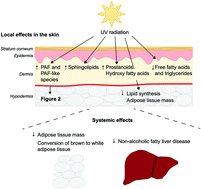Lipids in ultraviolet radiation-induced immune modulation
Abstract
Ultraviolet (UV) radiation-mediated immune suppression is a key mechanism conferring both detrimental and beneficial impacts of sun exposure on human health. Suppression of anti-tumour responses promotes the development and progression of UV-induced skin cancers. In contrast, suppression of dysregulated immune responses facilitate the therapeutic success of phototherapy treatment for skin disorders and is postulated to be responsible for UV protection from autoimmune diseases. While some of the molecular and cellular mechanisms underlying UV-suppression of the immune system are known, a relatively unexplored area is immunomodulatory lipids. Cutaneous UV exposure changes lipids both locally in the skin, increasing platelet-activating factor (PAF) production and decreasing free triglyceride levels, and systemically reducing adipose tissue mass. There is growing recognition that bioactive lipids and lipid metabolism directly affect immune cell phenotype and function. Manipulation of immunomodulatory lipid pathways are effective strategies in modifying systemic immune responses. Indeed, the PAF pathway is a key initiator of UV-induced immune suppression and antagonism of PAF-receptors restores immune function and reduces skin cancer development in mice. This review focuses on the known effects of UV on lipids and proposes how this may in turn be involved in the modulation of the immune system.

- This article is part of the themed collections: 2020 Perspective article collection and The World Congress on Light and Life, Barcelona 2019


 Please wait while we load your content...
Please wait while we load your content...